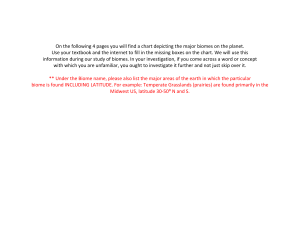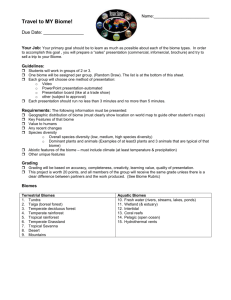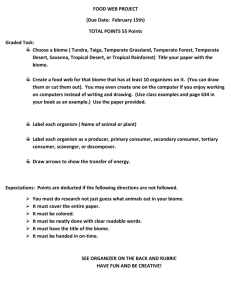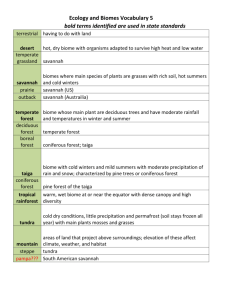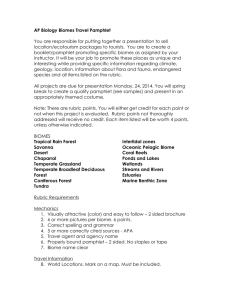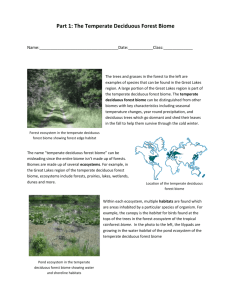Chart of Terrestrial Biome Characteristics
advertisement
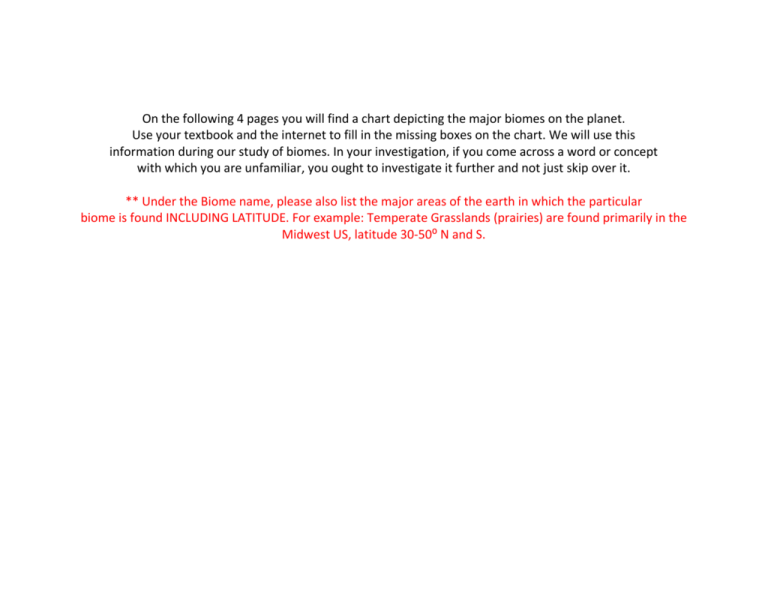
On the following 4 pages you will find a chart depicting the major biomes on the planet. Use your textbook and the internet to fill in the missing boxes on the chart. We will use this information during our study of biomes. In your investigation, if you come across a word or concept with which you are unfamiliar, you ought to investigate it further and not just skip over it. ** Under the Biome name, please also list the major areas of the earth in which the particular biome is found INCLUDING LATITUDE. For example: Temperate Grasslands (prairies) are found primarily in the Midwest US, latitude 30-50⁰ N and S. Name: __________________________________________________ Chart of Terrestrial Biome Characteristics The exact flora and fauna of each biome is dependent upon which continent the biome is found. Biome Precipitation Temperate Rainforest (cloud forest) Ample 200-300 cm, very foggy, leaf drip from fog condensing on needles provides much precip. Tropical Rainforest >200 cm Allows decay to occur at a very rapid rate Temperature Soils Representative Flora/Adaptations Mild winter, cool summers 8-20oC Representative Fauna Major Human Interferences Logging, dams (salmon) Old, thin, acidic nutrient poor because most nutrients are in the biomass; soil may harden to concretelike consistency – laterite soil (rusty red color due to high concentration of iron oxides (Fe & Al) from chemical weathering of underlying parent rock) Broadleaf evergreen trees; diverse species throughout forest; emergent layer of tall trees with a thick layer of canopy trees below. Trees may have buttresses (expanded bases) due to massive size and shallow roots; epiphytes (bromeliads, orchids); if thick canopy there is little to no plant life beneath. Biome Precipitation Temperature Tropical Seasonal Forest (tropical monsoon; tropical deciduous) Temperate Deciduous Forest Higher nutrients than tropical rainforest, but still nutrient poor, acidic, and highly leached 75-150 cm, even amounts throughout all seasons 0-20oC Boreal Forest (taiga, northern coniferous forest) Polar Grassland (arctic tundra) Alpine Tundra on Mountaintops Soils Representative Flora/Adaptations -20 to 10oC, Organic material is slow to decompose because so cold, short growing season, low biodiversity Major Human Interferences Insects; amphibians; reptiles; Australian marsupials, such as koala and kangaroo Logging, agriculture, invasive exotics, grazing, dams Wolverines, moose, caribou, bears, elk, migratory birds Logging, mining, fur trade, dams High nutrients due to deciduous trees, lots of humus and leaf litter Low plant diversity, primarily conifers such as pines, hemlocks, spruce, cedar, fir; some deciduous, like maples, aspen, birch; slow growing season <10 cm Representative Fauna Too cold for much human activity, Oil/natural gas drilling and associated transport issues, global warming Biome Temperate Grassland Precipitation Temperature 25-100 cm Fire maintained (In US called: prairie) Tropical Grassland (savanna) Chaparral (Mediterranean; temperate shrubland) (steppe) 50-150 cm Prolonged dry season, fire maintained 0-38oC Soils Representative Flora/Adaptations Representative Fauna Major Human Interferences Extremely nutrient rich, lots of humus-partially decomposed organic matter that holds in water and nutrients in soil, arises from grasses dying and decaying in winter Agriculture, livestock grazing if too dry for crops Low in minerals, easily leached, may have high levels of Aluminum. Edaphic (Living organisms are influenced mainly by the soil, not by climate) Livestock grazing, agriculture, poaching Deep roots; thick bark; Small, leathery, waxy leaves (sclerophyllous); Evergreen; Allelopathy; seeds require burning Urbanization, fires lead to flooding Biome Deserts Precipitation Temperature Depends on location, deserts usually at 30oN or 30oS of equator or interior of continents due to rain shadow effect -5 to 30oC Soils Representative Flora/Adaptations Representative Fauna Usually nocturnal; may aestivate (hibernation when hot); dry feces and highly concentrated urine; large grazers, such as gazelle, oryx; United States – small mammals such as kangaroo rats, coyotes, foxes, snakes, owls, hawks, roadrunners Major Human Interferences Off-road vehicles, Overgrazing, Urbanization, oil drilling, mining
